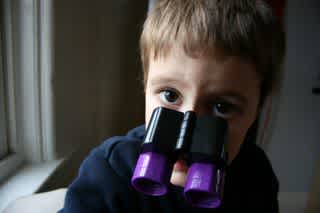Imagination: Seeing Through the Eyes
This past Tuesday, my older son and I had a very big experience: an emergency landing of a commercial airplane. We were informed that one of the two engines was not functioning; we were taught the “bracing” position for emergencies; and we were told that once landed, we would likely follow emergency exit procedures, leaving the plane on the wings and sliding down those big yellow puffy slides.
Now – first of all – everyone is fine, the plane is fine (needed some repairs), and the landing felt relatively normal. Ultimately, we made a normal exit off the plane and into the airport, like we’ve done many times before.
But during those the 30 minutes of flight before our landing, the people on the airplane were scared – really scared. They were in something of a nightmare trance. I could almost see the horrific images they were streaming in their imaginations: all the scenes from movies, newscasts and computer games of a “plane crash,” images of wind, terror, yelling, objects flying about. Can you conjure those too? I’ll bet you can.
And then there was my son. He was smiling. He was imagining the puffy yellow slide. He was imagining telling his friends the story. He was in his imagination. He didn’t have all of the media images to draw from, and so he was creating new images in his mind. And he was enjoying it.
Imagination is the self-creation of images. Imagination is not what is employed when we watch TV or movies or play video games. Those media provide the images for you. They give you the story, the emotion, the images, and they cement them securely in your mind. Then they remain in the recesses of your brain until called – usually by emotion. You feel love and immediately have references from the collection of romantic comedies you have seen. You feel anger and you immediately have references from underdog sports movies or war video games. And you feel fear in an airplane and you can call forth all those scary scenes in countless dramatic movies and television programs. They are there – ready for use.
The alternative is imagination, the images you create yourself. Like anything "creative," the images are alive – flexible – and all in context. Images from movies can be isolated because they were all "given" to you. You can pull single images out of context much easier because you didn’t put any effort into building them.
But when you build your own images – say, when listening to a story – you are the carpenter who knows every board, every nail, every measurement, and every swing of the hammer. You built it so you have control. You have control. This is what I call “seeing through the eyes.”
When you watch TV or movies or other media, you are beholden to the people who created what you are seeing. The director, the animator, the designer – they tell you what the heroine looks like. They tell you that the "bad guy" has a mustache. They tell you that the president is a white man or a black woman or a red head or a blonde. It is all built for you to consume.
When you “see with the eyes" and create your own images, you go through the eyes and empty into your imagination. You build it and you control it. And when you have control over your images, then it is much more difficult to control you.
When you have control over your own images, then it is much more difficult to control you.
Next week is “Screen Free Week” and families, schools, and institutions are trying an experiment: limited or no use of screens for a week. Children watch no TV, no movies, do not use the computer or mobile devices. Seems like a lot to commit to, but try to look at the experiment through this context.
Visual media has a lot of power. They create not only the images but the context. They have packaged experiences that become a part of you, and when you are stressed – like during an emergency landing of an airplane – you are vulnerable and go to those made-for-immediate-consumption images. You see Harrison Ford or Angelina Jolie or Chris Evans being tossed this way and that – wind blowing – stuff flying everywhere and you get really scared.
And meanwhile, a twelve-year-old boy is sitting next to you wondering what it will feel like to slide down a big inflated yellow slide – and he is smiling.
About the Author

David Sewell McCann
David Sewell McCann fell in love with spinning stories in first grade – the day a storyteller came to his class and captured his mind and imagination. He has been engaged in storytelling all of his adult life through painting, film-making, teaching and performing. Out of his experience as a Waldorf elementary class teacher and parent, he has developed a four step method of intuitive storytelling, which he now shares through workshops and through this website.

